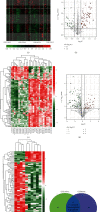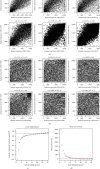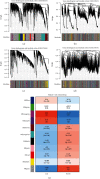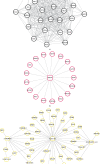Identification of Crucial lncRNAs, miRNAs, mRNAs, and Potential Therapeutic Compounds for Polycystic Ovary Syndrome by Bioinformatics Analysis
- PMID: 33224973
- PMCID: PMC7666708
- DOI: 10.1155/2020/1817094
Identification of Crucial lncRNAs, miRNAs, mRNAs, and Potential Therapeutic Compounds for Polycystic Ovary Syndrome by Bioinformatics Analysis
Abstract
Background: This study was aimed at mining crucial long noncoding RNAs (lncRNAs), microRNAs (miRNAs), and messenger RNAs (mRNAs) for the development of polycystic ovary syndrome (PCOS) based on the coexpression and the competitive endogenous RNA (ceRNA) theories and investigating the underlying therapeutic drugs that may function by reversing the expression of lncRNAs, miRNAs, and mRNAs.
Methods: RNA (GSE106724, GSE114419, GSE137684, and GSE138518) or miRNA (GSE84376 and GSE138572) expression profile datasets of PCOS patients were downloaded from the Gene Expression Omnibus database. The weighted gene coexpression network analysis (WGCNA) using four RNA datasets was conducted to construct the lncRNA-mRNA coexpression networks, while the common differentially expressed miRNAs in two miRNA datasets and module RNAs were used to establish the ceRNA network. A protein-protein interaction (PPI) network was created to explore the potential interactions between genes. Gene Ontology and KEGG pathway enrichment analyses were performed to explore the functions of genes in networks. Connectivity Map (CMap) and Comparative Toxicogenomics Database (CTD) analyses were performed to identify potential therapeutic agents for PCOS.
Results: Three modules (black, magenta, and yellow) were identified to be PCOS-related after WGCNA analysis, in which KLF3-AS1-PLCG2, MAPKAPK5-AS1-MAP3K14, and WWC2-AS2-TXNIP were important coexpression relationship pairs. WWC2-AS2-hsa-miR-382-PLCG2 was a crucial ceRNA loop in the ceRNA network. The PPI network showed that MAP3K14 and TXNIP could interact with hub genes PLK1 (degree = 21) and TLR1 (degree = 18), respectively. These genes were enriched into mitosis (PLK1), immune response (PLCG2 and TLR1), and cell cycle (TXNIP and PLK1) biological processes. Ten small molecule drugs (especially quercetin) were considered to be therapeutical for PCOS.
Conclusion: Our study may provide a novel insight into the mechanisms and therapy for PCOS.
Copyright © 2020 Zhi Zeng et al.
Conflict of interest statement
The authors declare that they have no competing interests.
Figures







Similar articles
-
Construction of a competing endogenous RNA network to identify drug targets against polycystic ovary syndrome.Hum Reprod. 2022 Nov 24;37(12):2856-2866. doi: 10.1093/humrep/deac218. Hum Reprod. 2022. PMID: 36223608
-
The lncRNA-miRNA-mRNA ceRNA network in mural granulosa cells of patients with polycystic ovary syndrome: an analysis of Gene Expression Omnibus data.Ann Transl Med. 2021 Jul;9(14):1156. doi: 10.21037/atm-21-2696. Ann Transl Med. 2021. PMID: 34430597 Free PMC article.
-
Bioinformatics Analysis of ceRNA Network Related to Polycystic Ovarian Syndrome.Comput Math Methods Med. 2021 Jun 9;2021:9988347. doi: 10.1155/2021/9988347. eCollection 2021. Comput Math Methods Med. 2021. PMID: 34211581 Free PMC article.
-
Identification of MFI2-AS1, a Novel Pivotal lncRNA for Prognosis of Stage III/IV Colorectal Cancer.Dig Dis Sci. 2020 Dec;65(12):3538-3550. doi: 10.1007/s10620-020-06064-1. Epub 2020 Jan 20. Dig Dis Sci. 2020. PMID: 31960204 Review.
-
Bioinformatics analysis of ceRNA network of autophagy-related genes in pediatric asthma.Medicine (Baltimore). 2023 Dec 1;102(48):e36343. doi: 10.1097/MD.0000000000036343. Medicine (Baltimore). 2023. PMID: 38050261 Free PMC article. Review.
Cited by
-
LINC00173 regulates polycystic ovarian syndrome progression by promoting apoptosis and repressing proliferation in ovarian granulosa cells via the microRNA-124-3p (miR-124-3p)/jagged canonical Notch ligand 1 (JAG1) pathway.Bioengineered. 2022 Apr;13(4):10373-10385. doi: 10.1080/21655979.2022.2053797. Bioengineered. 2022. PMID: 35441583 Free PMC article.
-
Messenger RNA Therapy for Female Reproductive Health.Mol Pharm. 2024 Feb 5;21(2):393-409. doi: 10.1021/acs.molpharmaceut.3c00803. Epub 2024 Jan 8. Mol Pharm. 2024. PMID: 38189262 Free PMC article. Review.
-
Biomarker potential of competing endogenous RNA networks in Polycystic Ovary Syndrome (PCOS).Noncoding RNA Res. 2024 Jan 17;9(2):624-640. doi: 10.1016/j.ncrna.2024.01.002. eCollection 2024 Jun. Noncoding RNA Res. 2024. PMID: 38571815 Free PMC article. Review.
-
Identification of Hub Genes and Biomarkers between Hyperandrogen and Normoandrogen Polycystic Ovary Syndrome by Bioinformatics Analysis.Comb Chem High Throughput Screen. 2023;26(1):126-134. doi: 10.2174/1386207325666220404101009. Comb Chem High Throughput Screen. 2023. PMID: 35379124
-
Long Noncoding RNA KLF3-AS1 Acts as an Endogenous RNA of miR-223 to Attenuate Gastric Cancer Progression and Chemoresistance.Front Oncol. 2021 Oct 21;11:704339. doi: 10.3389/fonc.2021.704339. eCollection 2021. Front Oncol. 2021. PMID: 34745937 Free PMC article.
References
MeSH terms
Substances
LinkOut - more resources
Full Text Sources
Medical
Miscellaneous

